Last updated: November 18, 2019
Article
Early Detection News – July 2018
July Surveys
The Invasive Species Early Detection Team (ISED) conducted July surveys at Point Reyes National Seashore and John Muir National Historic Site. Noteworthy detections this month included yellow star thistle, small leaf spiderwort, mourningbride, and poroporo.
Noteworthy Early Detections
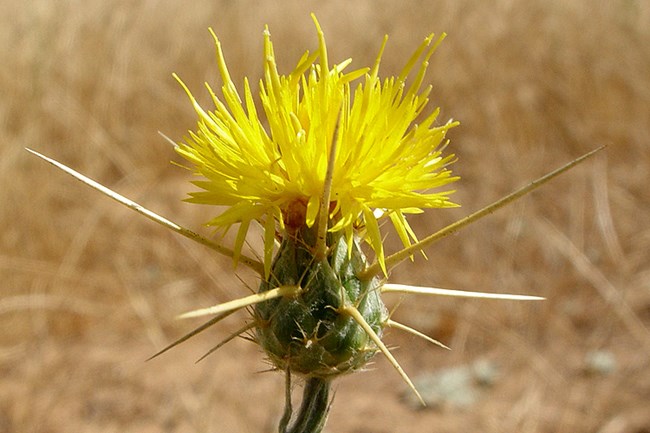
© Carol W. Witham / 2004 / CalPhotos / CC BY-NC-SA 3.0
Yellow Star Thistle
(Centaurea solstitialis)
In late June, ISED discovered and removed a small patch of yellow star thistle growing on the shoulder of Sacramento Landing Road. An additional single plant was also detected and removed along Sir Francis Drake Blvd. at B Ranch in July.
Yellow star thistle is one of the most invasive and damaging grassland weeds in western North America. It is native to the Mediterranean Basin, and was first discovered in California in 1869. It now infests over 12 million acres in California, and continues to expand in the Sierras and the central-western region. Yellow Star Thistle displaces native plants, lowers forage quality on rangelands, and can deplete soil moisture in annual California grasslands. It reproduces rapidly by seed, and is primarily dispersed by human activities. Large amounts of seed can adhere to vehicles and road maintenance equipment and to humans and animals to a lesser degree.
Yellow star thistle is currently uncommon in the coastal zones of Marin and San Mateo Counties. However, its suitable climate range is projected to expand towards the coast over the next 30 years, in response to climate change.
Resources:
Cal-IPC Plant Profile
CalFlora weed profile
Invasive Plants of California's Wildlands
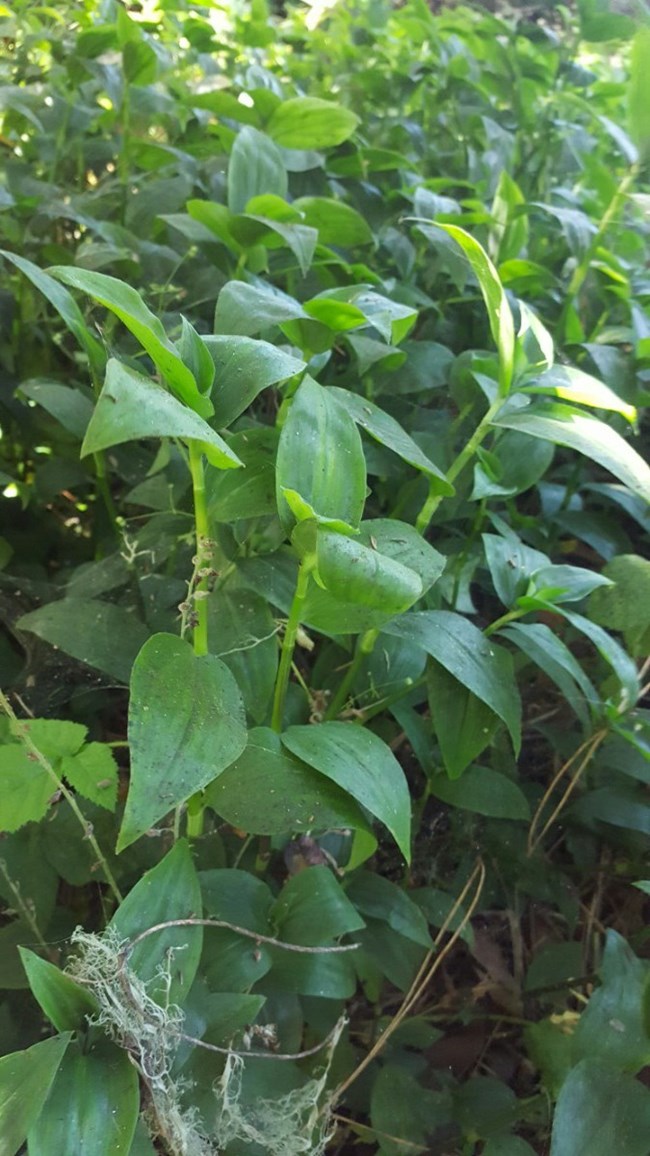
NPS / Sarah Inman
Small Leaf Spiderwort
(Tradescantia fluminensis)
In June ISED mapped a small patch of small leaf spiderwort at Point Reyes NS, near Sacramento Landing Road. This species was recorded in Point Reyes for the first time last year on the banks of Pine Gulch Creek at the Olema Valley Trail. Small leaf spiderwort is not widespread in California, but is widespread in Redwood Creek, and is spreading in riparian areas in Marin and Alameda counties.
Small leaf spiderwort is native to South America and is considered invasive in Florida, South Africa, Australia and New Zealand. It is a rhizomatous and perennial groundcover that can form carpet-like monocultures (up to 90cm deep) in moist and shady habitats. It has prostrate stems with alternate, glabrous leaves and small, white three-petaled flowers that appear April through July. Small leaf spiderwort is dispersed by vegetative fragments along streams or in yard waste and rubbish. As the plants spread over the forest floor they prevent the regeneration and establishment of native plants, decreasing species richness and abundance. This process eventually alters the structure and composition of the entire plant community.
In New Zealand, small leaf spiderwort has significantly degraded native forest remnants and control can prove difficult. Hand-pulling is exceptionally time-consuming because even very small fragments (greater than or equal to 1cm) must be collected to prevent regrowth. It is somewhat resistant to chemical control due to the plant’s smooth and waxy surfaces. In New Zealand Forests, neither hand-pulling nor herbicide application prevented regrowth even over repeated treatments.
Resources:
USDA PLANTS profile
Standish R. J. 2002. Experimenting with methods to control Tradescantia fluminensis, an invasive weed of native forest remnants in New Zealand. New Zealand Journal of Ecology 26: 161-170.
Standish R. J., Robertson A. W. & Williams P. A. 2001. The impact of an invasive weed Tradescantia fluminensis on native forest regeneration. Journal of Applied Ecology 38: 1253-1263.
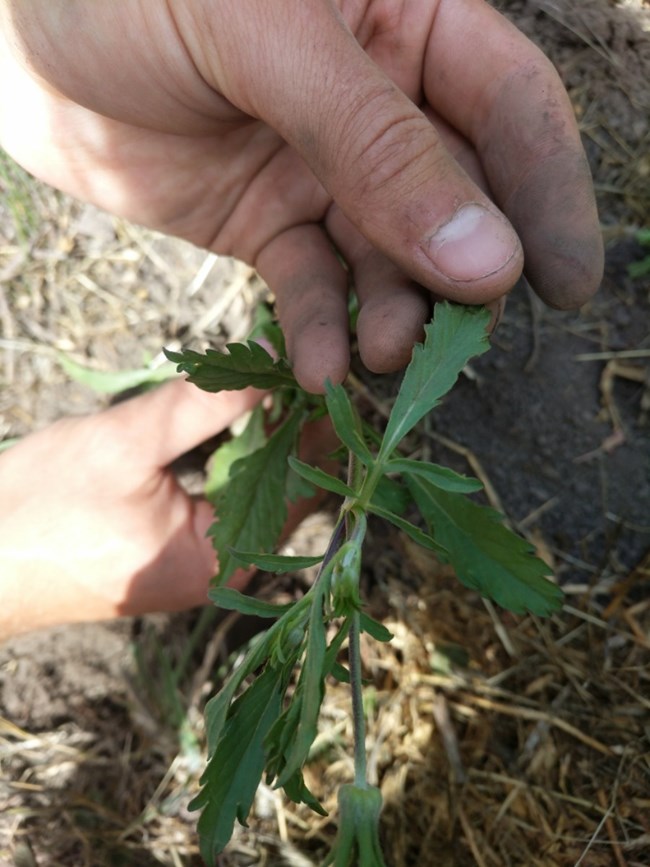
NPS / Sarah Inman
Mourningbride
(Scabiosa atropurpurea)
The early detection team followed up on a patch of Mourningbride along the Bayview Trail, which was last treated in 2014. The patch of 190 plants was approximately the same size as the previous treatment four years ago, indicating that more follow up will be necessary to achieve eradication. Mourningbride has only been detected at two locations in Point Reyes, but has been mapped and treated extensively in Golden Gate NRA, from Rancho Corral de Tierra to Stinson Beach. Therefore, it is a high priority for eradication at Point Reyes.
Mourningbride is native to northern Africa, southern Europe and western Asia. It is considered an invasive weed in Australia, and is on the Cal-IPC Watchlist. In San Bruno, it has been observed to form near-monotypic stands in grasslands.
Mourningbride is in the teasel family (dipsacaceae), and has large pink flowers atop long, thin bracts. The leaf shape is variable, basal leaves appear rounded and toothed, while cauline leaves are strongly dissected. The plant is somewhat woody. The Jepson eFlora describes Mourningbride as up to 0.6 meters tall, but we observed plants in the Bayview population growing to 1 meter.
Resources:
Weeds of Australia Fact Sheet
Jepson eFlora
Cal-IPC News Vol. 13, No. 4, Winter 2006
CAL-IPC Plant Profile
Calflora Observation Hotline
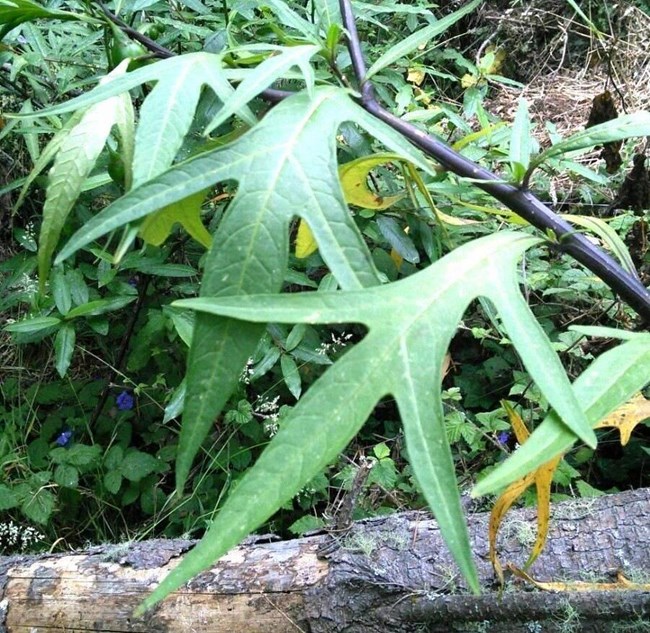
NPS / Sarah Inman
Poroporo
(Solanum aviculare)
ISED recorded several new occurrences of Poroporo in Point Reyes. Two sites were on Laguna trail, and a reported patch was confirmed along the Chimney Rock trail. Poroporo is a soft-wooded shrub characterized by deeply lobed leaves, blue-violet flowers, and round, green fruits that turn bright red-orange as they mature. Each fruit contains hundreds of seeds. This perennial plant can reach up to 12 feet in height. Like many other plants of the Solanaceae, the unripe fruits and leaves of this species are toxic to humans and animals.
Poroporo, also known as New Zealand nightshade or kangaroo apple, is native to the east coast of Australia and New Zealand. It has been introduced to other regions of those countries where it is now considered and environmental weed. Poroporo is also naturalized in Hawaii, where it is considered an invasive plant, and it is naturalized in Oregon and California, where its invasiveness is unknown. In Marin, plants have been found in Point Reyes NS on Limantour Road and at scattered locations along the coast from Stinson Beach to Muir Beach. We have also mapped substantial populations in San Francisco at the Presidio. Poroporo is typically found in loose soils and heavily disturbed areas.
Resources:
Cal-IPC Plant Profile
Jepson eFlora
USDA PLANTS profile
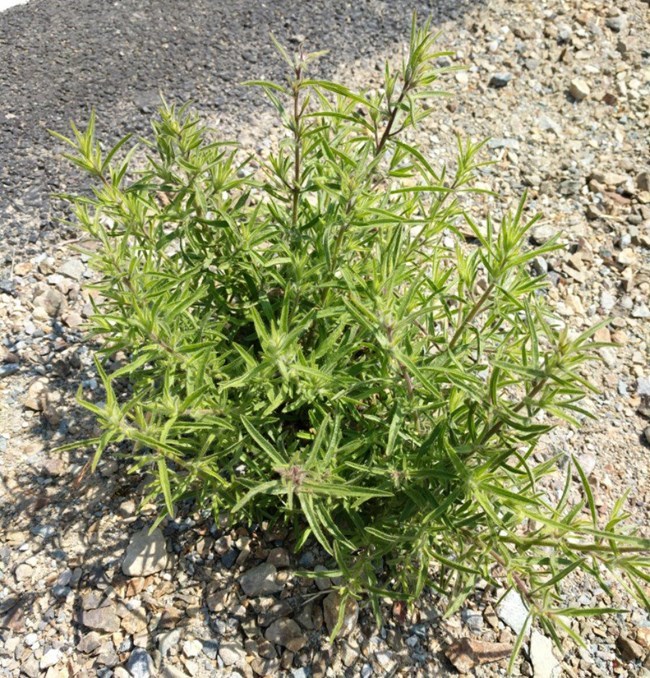
NPS / Sarah Inman
Stinkwort
(Dittrichia graveolens)
Since 2010, ISED has been mapping and controlling stinkwort infestations at John Muir National Historic Site. There are persistant populations at the Mount Wanda Trailhead, and at the Strentzel Creek entrance to the park. This year’s surveys on Mount Wanda confirm that outlier populations on Mount Wanda were successfully eradicated. There are large populations of stinkwort along the roads just outside of the park boundaries, so continual surveillance and control will be necessary to keep this rapidly spreading weed out of the park.
Stinkwort is a late-season winter annual in the Asteraceae family, native to Mediterranean North Africa. Its foliage is covered in strongly aromatic glandular hairs with a smell reminiscent of Pine-Sol. The plants bear small yellow flowers from September to December. Stinkwort has exponentially expanded its range in California since its initial discovery in 1984 in Santa Clara County. It is found in disturbed habitats, primarily along roadsides in California. It is introduced and spreading rapidly in Central Europe, and has been reported as invasive in Australia and South Africa. In its native range stinkwort inhabits riparian woodlands, margins of tidal marshes, vernal pools, and alluvial floodplains. It has invaded these types of habitats in some regions where it is introduced, and may ultimately become problematic in similar habitats in California.
A single plant can produce about 15,000 seeds, which are dispersed by wind over 600 feet, accelerating dispersal by animal fur/clothing, fill dirt, mowing and motor vehicles. Seeds can germinate at any time and are only limited by available soil moisture. Stinkwort is known to cause poisoning in livestock and the barbed seed heads can become embedded in sheep's intestines. The plant's sticky resin can cause contact dermatitis in humans. Cal-IPC rates the potential impact of stinkwort on native ecosystems in California as MODERATE Alert.
Resources:
Brownsey RN, Kyser GB, DiTomaso JM (2013) Stinkwort (Dittrichia graveolens) is rapidly expanding its range in California. Calif Agric 67:110–115
Cal-IPC Plant Assessment Form
July 2018 Survey Results
Click on a point in the map below to view additional details about a specific record. This month's ISED records may also be viewed in an interactive map at the Calflora Observation Hotline. Navigate to the Help Site for assistance using the Observation Hotline.
